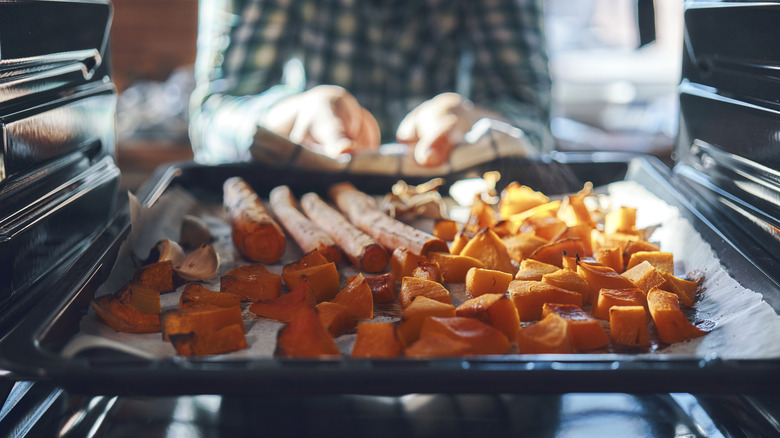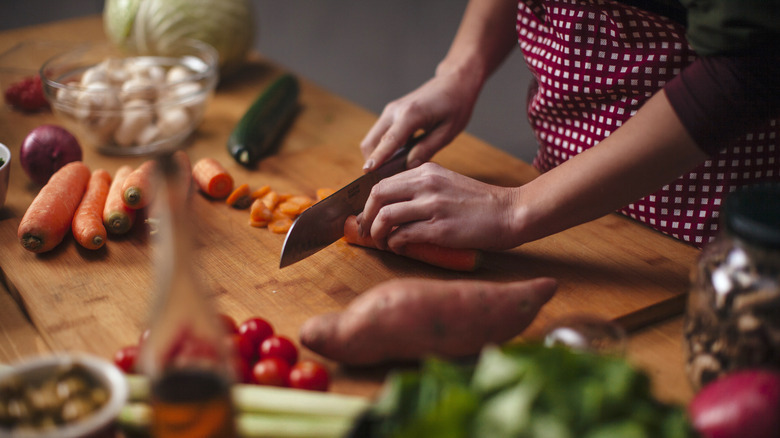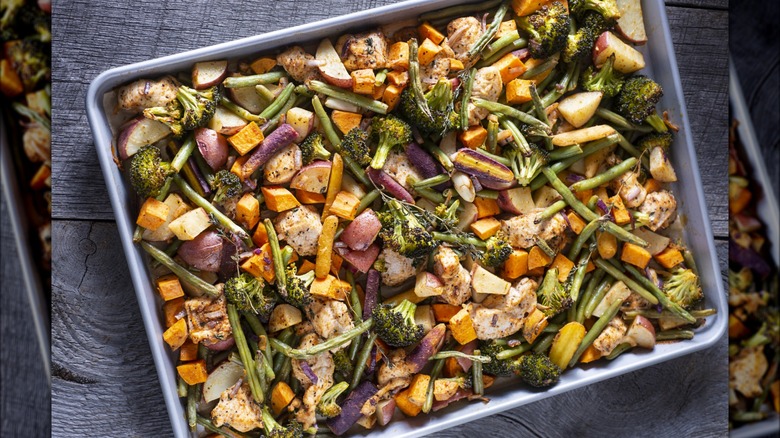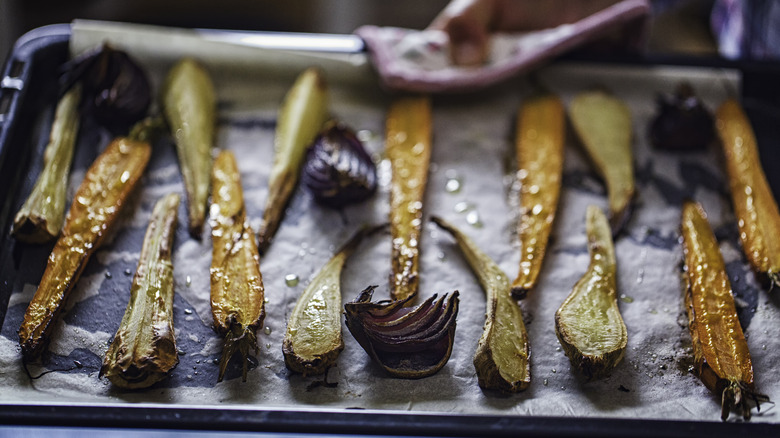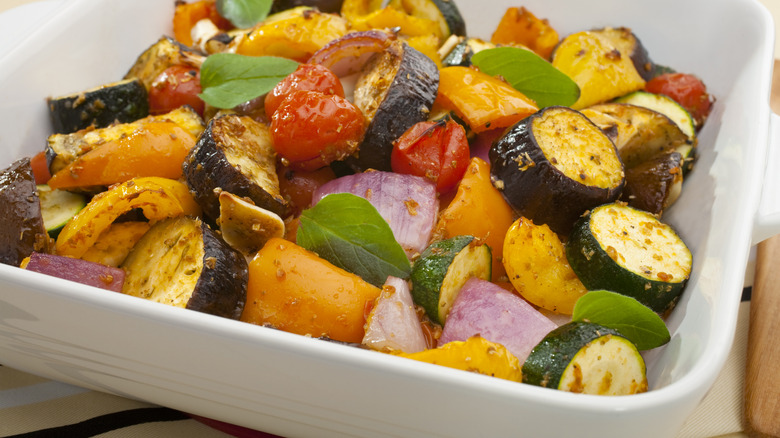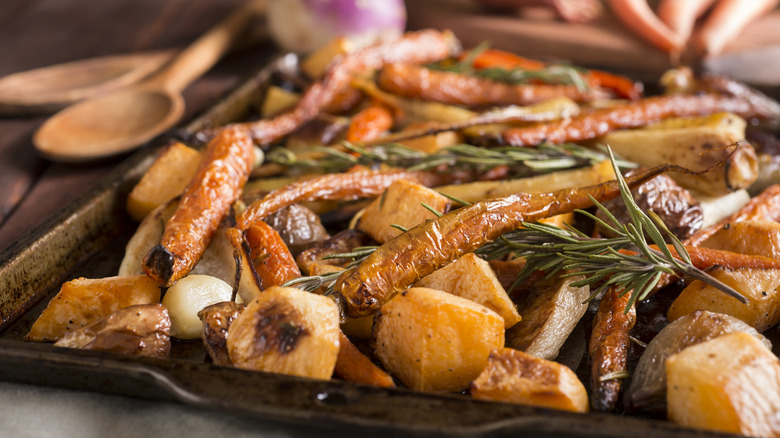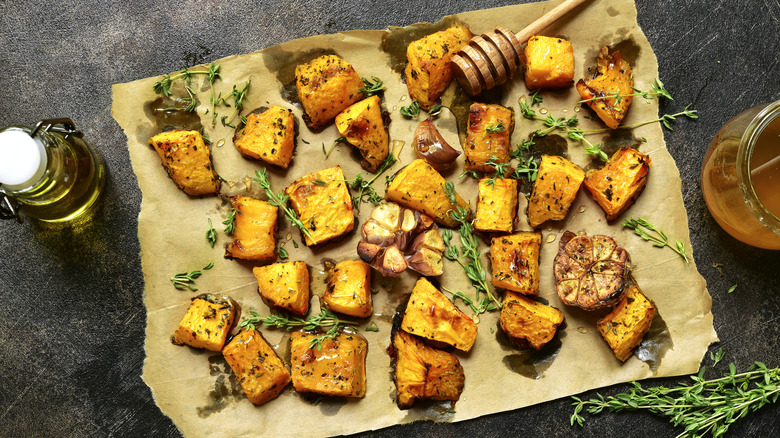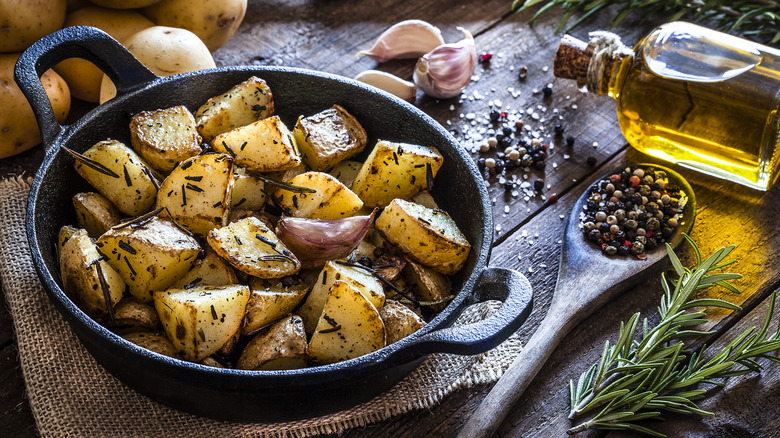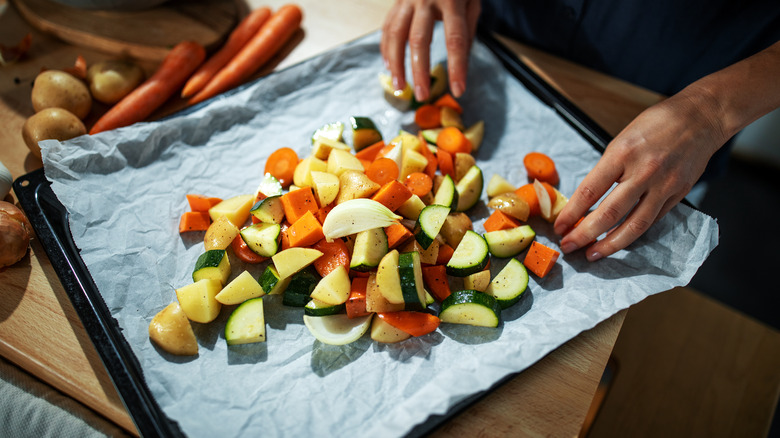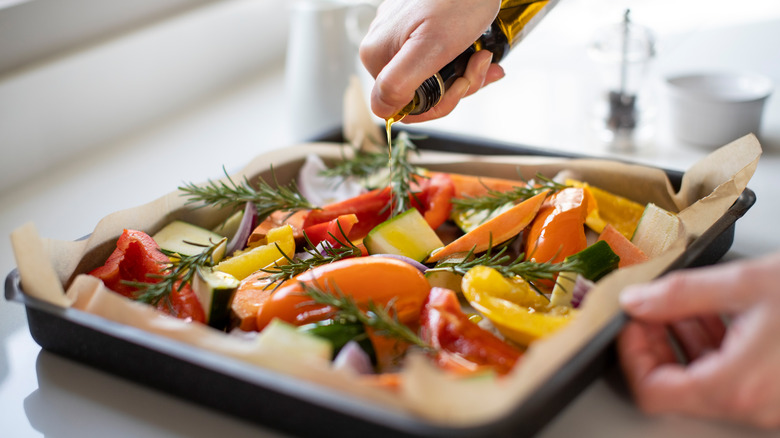9 Mistakes To Avoid When Roasting Vegetables
The traditional means of cooking vegetables has long been boiling, steaming, and sautéing. Roasting, on the other hand, only became a popular method to cook vegetables during the early 1990s. Speaking to The New York Times in 1993, executive chef Alfred Portale said: "Roasting sounds very appealing. Forgetting that it is a very practical cooking method, it's also a turn on. It conjures up sexy images of a roaring fire, and right now it holds a lot of interest."
Little has changed in the 30 years since Portale made this statement. Roasted vegetables are still seen as the crème de la crème of prepared vegetables, their crisp texture and intense flavor making a mockery of the over-boiled vegetables of yesteryear.
Yet, the rise of roasted vegetables has also facilitated a boom in poor roasting practices. Misguided temperatures, poor equipment choices, and bad preparation can all cause potentially perfect vegetables to come out of the oven mushy and disappointing. Fortunately, avoiding these mistakes is simple; all that is required is a little forethought.
1. Failing to chop the vegetables uniformly
All good cooking starts with competent cutting. Without the ability to create uniform pieces of food, there is no chance of having a consistent final dish. This is for a number of reasons. On a basic level, uniform cuts ensure that all pieces of a vegetable cook at the same rate; if you roasted a 1-inch-thick piece of butternut squash alongside a 1/4-inch slice, the latter would burn before the former had even cooked through.
What's more, different sizes and shapes of vegetables create a different eating experience. This was explained to NPR by the dean of culinary arts at the Culinary Institute of America, Brendan Walsh: "If you put a vegetable that is more rounded in your mouth, your mind is generally going to be thinking about something that has more of a succulence to it. Something cut in squares is going to be a little bit more toothsome, with a jagged edge, and will give the impression of something rugged or tough. Your mind will think something is flavorful if it is smoother."
In terms of roasted vegetables, cutting carries further importance as it controls the volume-to-surface-area ratio. A greater surface area, as seen in baton-shaped items, means more vegetable is in contact with the roasting pan or hot air, allowing more caramelization to take place. This can vastly alter the nature of the final dish.
2. Crowding the tray
An overcrowded baking tray, wherein vegetables are piled on top of one another, is the downfall of many a dish. Vegetables that are roasted in this way are going to come out of the oven soggy because steam is produced and trapped when pieces of vegetables touch or overlap. As the Maillard reaction requires dry heat to occur, vegetables roasted in these steamy conditions will never caramelize, negating one of roasting's key benefits.
Fortunately, overcrowding is easy to fix: Roast the vegetables over two trays to ensure there is space between each piece. This space allows the air to circulate, preventing steam from building up and ensuring food remains relatively dry. Chef Adam Liaw suggested to The Daily Mail: "Instead of trying to fit that little bit extra in, I'd recommend using a second pan or cooking in batches which will give the moisture in your food more chance to escape and avoid everything going soggy."
3. Not turning the vegetables
Metal is a much better conductor and transmitter of heat than air. Consequently, when vegetables are roasted in the oven, the parts that are touching the metal baking sheet will cook quicker than those exposed to air. If left unattended, this can result in one side of the vegetable burning before the other side browns. Turning vegetables part way through the roasting process will prevent this from happening.
For those looking for extremely uniform results, vegetables can be turned so each side spends an equal amount of time in contact with the baking sheet. For example, rectangular French fries should be turned three times, giving each of the four sides sufficient contact time with the metal tray.
A lot of ovens have hot spots and cool spots. These are found in all types of ovens, including convection ovens, for a variety of reasons. Flipping and moving the vegetables around will also minimize the effects of any hot spots, reducing the risk of vegetables becoming burnt.
4. Roasting them at low temperatures
When roasting vegetables, heat is your friend. Many sources point to high temperatures – 450 degrees Fahrenheit and above — being perfect for roasting vegetables. This is because such intense levels of heat all but guarantee that the vegetables will become crisp and browned. These high temperatures, however, are not well-suited to roasting large pieces of vegetables – the outside will burn long before they are cooked through.
The Maillard reaction begins at temperatures around 300 degrees Fahrenheit. Caramelization, at temperatures around 320 degrees Fahrenheit. Consequently, roasting vegetables at temperatures below 300 degrees Fahrenheit ensures your vegetables will never acquire the flavorful browning many find appetizing.
However, there are some instances vegetables can benefit from a low-and-slow approach. Roasting in this manner shrivels the vegetables and gives their flesh a soft texture. Free from the strong flavors imparted during the Maillard reaction, these vegetables can play an excellent supporting role in a dish, whole-roasted Heritage carrots being a prime example.
5. Using the wrong equipment
Even if a cook does everything right, the wrong equipment can quickly derail a recipe. This is true for roasted vegetables which require a suitable dish to be cooked in. One of the worst dishes to roast vegetables in are casserole dishes. These high-sided dishes cause vegetables to turn mushy as their high sides limit the amount of evaporation that takes place. Ultimately, this results in more steam being produced amongst the vegetables which, in turn, inhibits the Maillard reaction.
Another reason why high-sided dishes result in mushy vegetables is that they reduce air circulation. This means that steam produced by the vegetables is not dispersed. Over prolonged periods of time, the constant presence of steam softens the vegetables to an unappetizing degree.
Of course, a completely rimless sheet poses its own problems. Namely, that any liquid, or even vegetables, might fall from it and burn on the oven's floor. As such, we advise the use of a low-rimmed baking sheet.
6. Failing to use sugar
Caramelization arises when sugars break down. Vegetables high in natural sugars, such as carrots, caramelize well because there are plenty of sugars to be broken down. Those vegetables that are not abundant in natural sugars, like celery, fail to demonstrate similar levels of caramelization, which can be a cause of disappointment for diners.
For these low-sugar vegetables, the addition of sugar, either in a pure form through products like honey or molasses, can aid the caramelization process. Even tossing in a simple syrup can result in a browning to rival that of high-sugar vegetables.
Of course, vegetables will be sweeter after this addition of sugar — a fact that should be taken into account when preparing a dish. After all, no one wants their main course to taste like a dessert. The high sugar content of syrups or honey also means the vegetables are at a higher risk of burning. Consequently, sugared vegetables should be watched closely when in the oven.
7. Seasoning your vegetables incorrectly
The importance of seasoning cannot be overstated. Adding salt not only elevates the flavors of every ingredient, it also creates cohesion between the flavors of different ingredients — an important facet when it comes to mixed, roasted vegetables. This was explained by chef Preeti Mistry to Wired: "I'll toss broccoli with salt, ginger, garlic, cumin, and soy and let it sit out for a couple of hours. If you do it in advance, your flavors create cohesion with the vegetables."
Adding salt is not the only way to season roasted vegetables, however. Many of them benefit from the addition of woody herbs like rosemary and thyme. These herbs need to be cooked in order to soften and can be thrown in alongside the vegetables as they roast. During this process, strong-tasting, aromatic oils leak out of the herbs, flavoring the entire tray of vegetables and adding an extra layer of complexity to the final dish.
8. Roasting all vegetables for the same period of time
All too often, a variety of vegetables are all thrown onto a baking sheet and put into the oven together. This approach, while simple, ignores that each type of vegetable has its own cooking time. When lumped together, the result is that some vegetables become overcooked while others remain partly raw.
To avoid this, vegetables that take the longest to cook — root vegetables and moist vegetables like peppers – should be added to the oven first. Once some time has elapsed, other vegetables with shorter cooking times can be added, including cruciferous vegetables such as Brussels sprouts. Finally, about 10 minutes before the vegetables are done, thin vegetables, like green beans, can be added.
An alternative approach is to roast every type of vegetable separately. This method allows the cook to closely monitor each vegetable type as it cooks. However, cooking in multiple batches will greatly increase the amount of time it takes to make a dish of mixed, roasted vegetables.
9. Using the incorrect amount of oil
Most people coat their vegetables in oil before roasting. This simple mistake can also negatively impact roasted vegetables if done incorrectly. Using too much oil can actually cause the vegetables to become soggy. On the other hand, too little oil can leave the vegetables dry. To avoid this, cooks should use 2 tablespoons of oil per baking sheet.
That being said, dry roasting is another method of roasting vegetables that is gaining traction in culinary circles. This method uses no oil during the cooking process, allowing the vegetables' true flavor to come to the fore. This was highlighted by chef Nick Balla to Food & Wine: "Summer squash gets this incredible tropical aroma, like really ripe mango or papaya but more vegetal [...] Everything is going to retain more aroma with a dry technique. Your pie has a little bit more of the aroma of the actual fruit or vegetable that you are roasting. It's almost always going to yield a better product."
